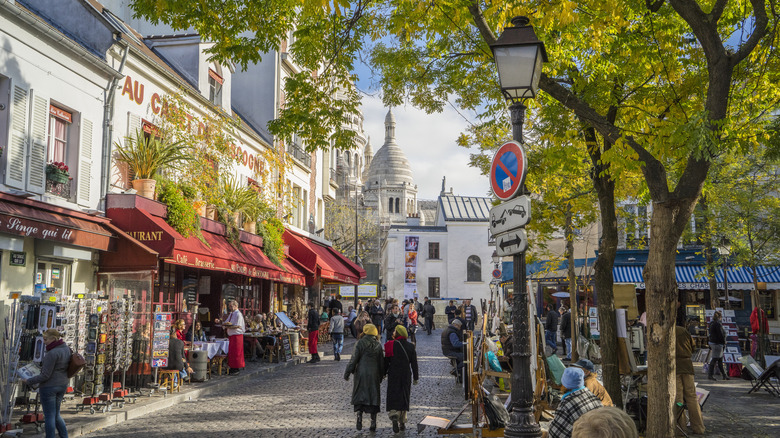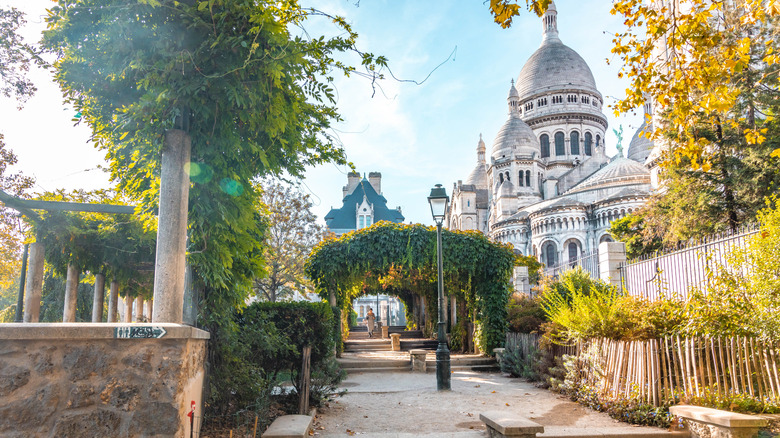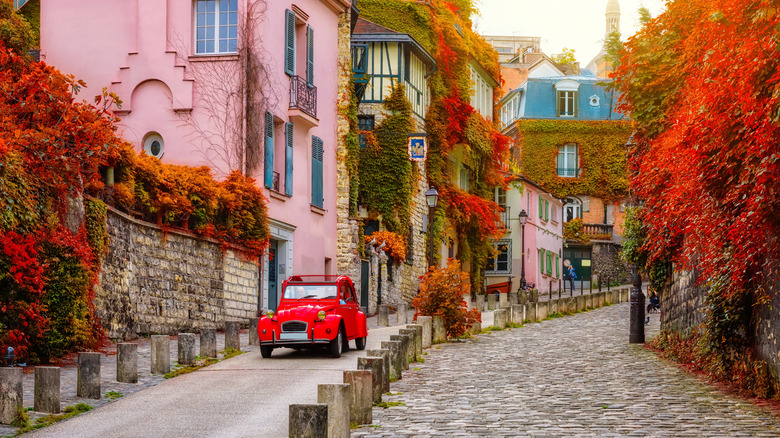The Charming Village In The Heart Of Paris That Is A Perfect French Cliché, Per Rick Steves
Montmartre is, according to Rick Steves, "the perfect French cliché," a description that will either have you cooing and booking with interested delight or turning up your oh-so-well-traveled nose at the word "cliché," pinky up, shuddering as if a cockroach were scuttling past. But Paris is a city that flips the idea of cliché on its silly head. Once you're in the City of Lights and Love, you'll be eating clichés like croissants for breakfast and worshipping every second of it. The city is every bit as beautiful and luminous and dirty and perfect as the postcards, movies, and paintings depict, and you get nothing short of the quintessential Parisian experience in the Bohemian neighborhood of Montmartre.
Whether this is your first or fifth trip to Paris, Montmartre is charming, complicated, and intimate enough to have you wrapped around its little finger and call you back time and time again. When you leave Montmartre, you dream of the ethereal tranquility that settles in the evenings, of a moon peaking out behind the sky-piercing spire of Sacré-Cœur, of your twilight picnic with fresh baguettes and wine, of the morning you spent in the cafe Au Cliron des Chausseur, where Hemingway used to frequent, or of witnessing painters fully absorbed with their latest creation on propped easels in the Place du Tertre. Montmartre is where you wander quaint cobblestone streets with the ghosts of individuals like Picasso, Renoir, and van Gogh, and where it finally hits home, with sweet abandonment, just how exquisite and inspiring Paris truly can be.
Why Montmartre is one of the highlights of Paris
Perched high above the city in the 18th arrondissement, the heart of chic Montmartre is undoubtedly the supreme, dominating Basilique du Sacré-Cœur, one of the most visited landmarks in Paris and the second-most visited religious building in France, after the Notre-Dame. Right around the corner, you can find Place du Tertre, the Artists' Square, where dozens of painters set up their easels daily in a gorgeous, cafe-lined courtyard, and you could have your own portrait painted! Where else can you enjoy such simple and incredible artistry in real time?
There is also the famous cabaret Moulin Rouge at the base of the la butte Montmartre. Little galleries, chocolate shops, and cafes like La Maiso delight anyone who wanders up and down the cobblestone streets. What's nice about Montmartre is that it is removed and small enough that it offers a relieving escape from the grand, traffic-filled promenades of the lower city and, as Rick Steves succinctly puts it, "still retains some of the untamed appeal that drew fin-de-siècle bohemians and nonconformists to its winding lanes." Bakeries exude wonderful fresh baking smells you are encouraged to catch in the early mornings before the rest of the world wakes. Restaurants in the area keep the evening atmosphere vibrant but not overwhelming. The network of historically significant sites and landmarks will keep every history geek and artistic heart enchanted.
Montmartre is more than a French cliché
Yes, Montmartre is a cliché delicious enough to be eaten, but it is more than just that. Save overdone understatements like "Montmartre packs a punch" or "Montmartre has everything you could ask for" for your travel guide to NYC. Montmartre is ... sassy — watch out for those pickpockets. It is also a workout — get your steps in on the hills and 38 staircases that take you up and down, up and down, to the second highest point in Paris, right after the Eiffel Tower. Montmartre is haunted. Famous artists of the Belle Epoque created, lived, and died here, and their presence is still felt and celebrated.
Montmartre is beautiful enough to crack the coldest heart. Just try standing at the steps of Sacre-Cœur, gazing over the stunning panorama of the city, and mumbling something about your eyedrops making your vision blur. Montmartre is romantic. Live music drifts in the evening air, and you can find new treasures around every street corner. Montmarte has a chip on its shoulder, well-known for its semi-rebellious, cool-kid-up-on-the-hill reputation and history, overrun by all kinds of artists and cabaret dancers with flashing underskirts. You'll see street art saying "Bobos, cassez-vous!" (Bobos, get the hell out of here), a call from more traditional Montmartre locals to the more recent Bohemian generations. Montmartre is, as Rick Steves says, "equal parts charm and kitsch — still vaguely small-town rustic but mobbed with tourists and pickpockets on sunny weekends." There are so many neighborhoods for you to explore in the expanse of Paris, but Montmartre is the cliché that you really, really can't miss out on.


